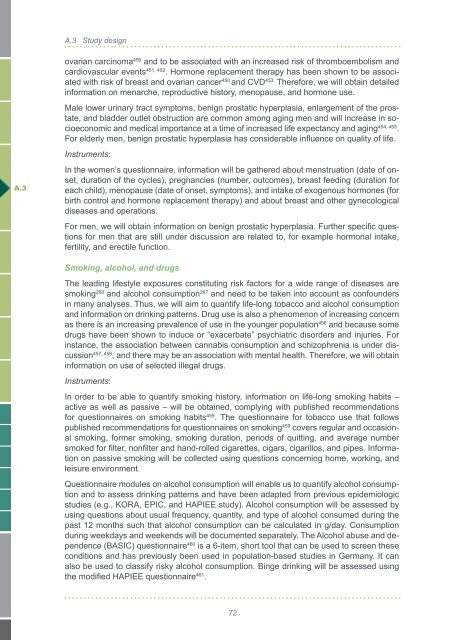Scientific Concept of the National Cohort (status ... - Nationale Kohorte
Scientific Concept of the National Cohort (status ... - Nationale Kohorte
Scientific Concept of the National Cohort (status ... - Nationale Kohorte
You also want an ePaper? Increase the reach of your titles
YUMPU automatically turns print PDFs into web optimized ePapers that Google loves.
A.3<br />
A.3 Study design<br />
ovarian carcinoma 450 and to be associated with an increased risk <strong>of</strong> thromboembolism and<br />
cardiovascular events 451, 452 . Hormone replacement <strong>the</strong>rapy has been shown to be associated<br />
with risk <strong>of</strong> breast and ovarian cancer 450 and CVD 453. Therefore, we will obtain detailed<br />
information on menarche, reproductive history, menopause, and hormone use.<br />
Male lower urinary tract symptoms, benign prostatic hyperplasia, enlargement <strong>of</strong> <strong>the</strong> prostate,<br />
and bladder outlet obstruction are common among aging men and will increase in socioeconomic<br />
and medical importance at a time <strong>of</strong> increased life expectancy and aging 454, 455 .<br />
For elderly men, benign prostatic hyperplasia has considerable influence on quality <strong>of</strong> life.<br />
Instruments:<br />
In <strong>the</strong> women’s questionnaire, information will be ga<strong>the</strong>red about menstruation (date <strong>of</strong> onset,<br />
duration <strong>of</strong> <strong>the</strong> cycles), pregnancies (number, outcomes), breast feeding (duration for<br />
each child), menopause (date <strong>of</strong> onset, symptoms), and intake <strong>of</strong> exogenous hormones (for<br />
birth control and hormone replacement <strong>the</strong>rapy) and about breast and o<strong>the</strong>r gynecological<br />
diseases and operations.<br />
For men, we will obtain information on benign prostatic hyperplasia. Fur<strong>the</strong>r specific questions<br />
for men that are still under discussion are related to, for example hormonal intake,<br />
fertility, and erectile function.<br />
Smoking, alcohol, and drugs<br />
The leading lifestyle exposures constituting risk factors for a wide range <strong>of</strong> diseases are<br />
smoking 268 and alcohol consumption 267 and need to be taken into account as confounders<br />
in many analyses. Thus, we will aim to quantify life-long tobacco and alcohol consumption<br />
and information on drinking patterns. Drug use is also a phenomenon <strong>of</strong> increasing concern<br />
as <strong>the</strong>re is an increasing prevalence <strong>of</strong> use in <strong>the</strong> younger population 456 and because some<br />
drugs have been shown to induce or “exacerbate” psychiatric disorders and injuries. For<br />
instance, <strong>the</strong> association between cannabis consumption and schizophrenia is under discussion<br />
457, 458 , and <strong>the</strong>re may be an association with mental health. Therefore, we will obtain<br />
information on use <strong>of</strong> selected illegal drugs.<br />
Instruments:<br />
In order to be able to quantify smoking history, information on life-long smoking habits –<br />
active as well as passive – will be obtained, complying with published recommendations<br />
for questionnaires on smoking habits 459 . The questionnaire for tobacco use that follows<br />
published recommendations for questionnaires on smoking 459 covers regular and occasional<br />
smoking, former smoking, smoking duration, periods <strong>of</strong> quitting, and average number<br />
smoked for filter, nonfilter and hand-rolled cigarettes, cigars, cigarillos, and pipes. Information<br />
on passive smoking will be collected using questions concerning home, working, and<br />
leisure environment.<br />
Questionnaire modules on alcohol consumption will enable us to quantify alcohol consumption<br />
and to assess drinking patterns and have been adapted from previous epidemiologic<br />
studies (e.g., KORA, EPIC, and HAPIEE study). Alcohol consumption will be assessed by<br />
using questions about usual frequency, quantity, and type <strong>of</strong> alcohol consumed during <strong>the</strong><br />
past 12 months such that alcohol consumption can be calculated in g/day. Consumption<br />
during weekdays and weekends will be documented separately. The Alcohol abuse and dependence<br />
(BASIC) questionnaire 460 is a 6-item, short tool that can be used to screen <strong>the</strong>se<br />
conditions and has previously been used in population-based studies in Germany. It can<br />
also be used to classify risky alcohol consumption. Binge drinking will be assessed using<br />
<strong>the</strong> modified HAPIEE questionnaire 461 .<br />
72



